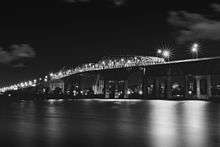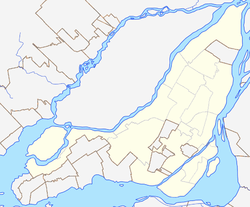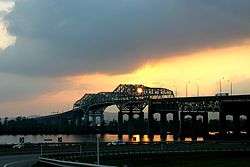Champlain Bridge, Montreal
| Champlain Bridge Pont Champlain | |
|---|---|
 Photo of the Champlain Bridge as seen from the south shore. You can see the new bridge (which will open in 2018) being constructed in the distance. | |
| Coordinates | 45°28′07″N 73°31′03″W / 45.46861°N 73.51750°WCoordinates: 45°28′07″N 73°31′03″W / 45.46861°N 73.51750°W |
| Carries | Autoroute 10, 15, 20 |
| Crosses |
St. Lawrence River and Saint Lawrence Seaway |
| Locale | Brossard and Montreal, Quebec, Canada |
| Owner | The Jacques Cartier and Champlain Bridges Inc. |
| Maintained by | The Jacques Cartier and Champlain Bridges Inc. |
| Website |
pontchamplainbridge |
| Characteristics | |
| Design | Steel truss Cantilever bridge |
| Material | Steel, Concrete |
| Total length |
3,440 m (11,286 ft) 7,412 m (24,318 ft) (including approaches)[1] |
| Longest span | 215.5 m (707.02 ft)[1] |
| Clearance below | 36.6 m (120 ft) at mid-span[1] |
| Number of lanes | 6 |
| History | |
| Designer |
Philip Louis Pratley Henry Hugh Lewis Pratley |
| Engineering design by |
Philippe Ewart Lalonde and Valois |
| Constructed by |
Atlas Construction Company Limited McNamara (Quebec) Limited The Key Construction Inc. Deschamps & Bélanger Limitée Dominion Bridge Company |
| Construction begin | 1957 |
| Construction cost |
C$35 million C$52 million (including approaches and Bonaventure Expressway) |
| Opened | June 28, 1962 |
| Statistics | |
| Daily traffic | 159,000[2] |
| Toll | Collected until 1990 |
 | |
The Champlain Bridge (French: Pont Champlain) is a steel truss cantilever bridge with approach viaducts constructed of prestressed concrete beams supporting a prestressed concrete deck paved with asphalt. The bridge crosses the Saint Lawrence River and Saint Lawrence Seaway, connecting the Montreal boroughs of Verdun and Le Sud-Ouest to Brossard on the South Shore.
The bridge, with approaches, is approximately 6 km (3.7 mi) long. When the project began, it was designated as the "Nuns' Island Bridge" because it crosses over Nuns' Island. In 1958, it was officially named the Champlain Bridge in honour of the explorer Samuel de Champlain, who founded Quebec City in 1608.
Together with the Jacques Cartier Bridge, it is administered by the Jacques Cartier and Champlain Bridges Incorporated (JCCBI), a Canadian Crown Corporation which reports to Infrastructure Canada.
The bridge sees about 50 million crossings per year of which are 200,000 buses. On an average weekday, 66% of users are commuters. It is one of the busiest single-span bridges in Canada.[3]
The concrete structure has been degraded by the use of de-icing salt, requiring expensive mitigation. In 2016 construction began on a replacement bridge designed to handle higher volumes of traffic.[3]
Specifications
The Champlain Bridge project was undertaken in 1955 and construction proceeded between 1957 and 1962. The bridge carries six lanes of vehicle traffic; three in each direction. During rush hour one lane of those heading off the island in the morning, and onto the island in the evening, is used as a reserved bus lane for buses to be able to head in the opposite direction. The bridge was opened to traffic in stages as the approaches were completed between June, 1962 and September, 1964. It was subsequently connected to the Bonaventure Expressway, which is part of the north approach to the bridge. The expressway was opened to traffic on April 21, 1967. Approximately 49 million vehicles and 196 million people cross the Champlain Bridge annually, making it one of the busiest bridges in the world.
- Total length of crossing complex: 14.5 km (9 mi)
- Total bridge length including approaches: 7,412 m (24,318 ft)
- Length: abutment to abutment: 3,440 m (11,290 ft)
- Link of viaduct to Section 1: 2,195 m (7,201 ft)
- Center main cantilevered span: 215 m (705 ft)
- Wellington Street approach: 365 m (1,198 ft)
- Bonaventure Expressway: 4,573 m (15,003 ft)
Just upstream from the bridge there is an ice boom, the Champlain Bridge Ice Control Structure.
Construction history

On August 17, 1955, federal Transport Minister George Marler first announced the planned construction of a new bridge connecting Montreal to the South Shore via Nun's Island. The city's existing bridges (Victoria, Jacques Cartier and Honoré Mercier) had become inadequate to support the amount of traffic that carried residents from the growing South Shore suburbs into Montréal.
The National Harbours Board was placed in charge of the project. Through several lengthy meetings and consultations in the fall of 1955, the location for the bridge and its approaches were selected. Originally, the plan had been to build the bridge with only 4 lanes, with room for further expansion to 6 lanes. During the design phase, however, it was decided to go with an initial 6-lane design immediately.
The bridge was opened on June 29, 1962. At the time, the bridge had only one approach from Montreal, via Wellington Street. The section of the bridge that includes the approaches to and from Atwater Street and La Vérendrye Boulevard were opened two years later, on December 7, 1964.
In 1967, the final approach to the bridge on the Montréal side was completed when the Bonaventure Expressway was opened to traffic.[4]
A $0.25 toll ($0.08 if paid with tokens) was charged to finance the $35 million cost of the Champlain Bridge. The toll was collected until 1990, when the Jacques Cartier and Champlain Bridges Incorporated (JCCBI), which took over jurisdiction of the bridge a dozen years earlier, removed the toll plaza.[5] Currently, a new toll project exists which may result in booths returning to the predetermined spaces on Île-des-Soeurs, so that drivers can be charged for entering and exiting Montréal. The toll will not be higher than $2.00 at the beginning.
Structural health
Montreal's climate subjects the Champlain Bridge to wintry cold, snowfall, and windy conditions, all of which accelerate damage to the bridge. Because of the potential danger from ice accumulation, the bridge has been salted every season for decades. But salt attacks both the concrete and steel rebar used in girders, pylons, and other parts.
In 2009 the Government of Canada announced in its 2009 Economic Action Plan that it would be allocating $212 million to renew the bridge. And in March 2011, the Government of Canada announced $158 million would be spent on a major repair and maintenance program as concerns mount it is at risk of collapse. Montreal's La Presse newspaper cited two leaked engineering reports prepared for a federal bridge agency that suggest sections of the structure are in a severe state of deterioration that will progress exponentially. The report concludes that a partial or complete collapse of the span should not be ruled out.[6]
In 2010, JCCBI — the Federal agency that oversees the structure — retained international engineering firm Delcan to carry out an expert study of the bridge's structural health. The firm returned a report entitled, "The Future of the Champlain Bridge Crossing". In the Executive Summary, the bridge was said to be "functionally deficient" for both current and long-term traffic demands, and showing "significant deterioration".[7] One finding suggested that the Champlain Bridge is in "very much poorer condition than would be typical" for comparable bridges. Delcan concluded that the bridge had "many deficiencies" and, even in light of the methodical inspection and rehabilitation of the structure undertaken by its owners, that continued operation "entails some risks that cannot altogether be quantified".
The CBC Television and Télévision de Radio-Canada, among other news agencies, have published segments highlighting concerns over conditions of surface roads in Montreal and the Champlain Bridge in particular.
In November 2013, a crack was discovered in a critical part of the superstructure. One lane was closed immediately and emergency repair plans were put in place. During preparation, the crack enlarged and a second lane was closed.[8]
Replacement bridge
Planning
In September 2007, the newspaper, Le Journal de Montréal, published a story about federal government plans to build a new 10-lane span next to Champlain Bridge, rather than face the increasing maintenance cost of the aging structure.[9] Federal minister Lawrence Cannon confirmed that his ministry was seriously considering the prospect of a new bridge.[10]
One month later, Novaroute, a private firm, revealed a plan to construct a two-story tunnel bridge under the river. It would contain two levels, one for buses and trains and another for all other vehicles except tractor-trailers. The tunnel would be a public-private partnership taking five years to complete, and would collect tolls.[11]
In August 2008, Transport Canada, the federal ministry of transportation, confirmed that studies and scenarios were ordered to build a new bridge within 10 or 15 years. The new structure would likely be 8 to 10 lanes wide and include a light rail train to connect the South Shore to Montreal.[12][13]
In October 2011, Denis Lebel announced that the federal government would build a replacement bridge, in a plan that would take about 10 years.[14][15] In December, 2013, he announced that the replacement bridge would be finished by 2018.[16]
In November, 2014, it was reported that the bridge would be named the Maurice Richard Bridge in honour of Montreal Canadiens ice hockey player,[17] but soon afterwards the plan was dropped due to a request from his family.[18]
A study had estimated that a per-trip toll of $2.60 to $3.90 until 2030 would be required to break even on the bridge's construction,[19] however in the 2015 federal election campaign, Liberal leader Justin Trudeau promised that the new bridge would be toll-free and this was confirmed following his election as prime minister.
The rapid development plan did not leave time for an international design competition, and designer Poul Ove Jensen was selected. In April 2015, The federal government selected the JV consortium: Signature on the St. Lawrence Group to build the new bridge. The consortium mainly includes: SNC-Lavalin, ACS Infrastructure and Dragados Canada.
Construction
Construction began in June 2015, with the new bridge expected to open 42 months later in December 2018.[20]
The bridge will include a two-lane public transit corridor for either buses or light rail, a six lane corridor for vehicles, and a multi-use corridor for cyclists and pedestrians. Components of the 4 billion dollar project include:[3]
- The new Champlain Bridge
- A new Autoroute 10 approach
- A new île-des-Sœurs bridge and a highway on île-des-Sœurs
- Improvements to nearby parts of the Autoroute 15.
The existing bridge will be demolished, along with the Champlain Bridge Ice Control Structure, once the new bridge is complete.
See also
References
- 1 2 3 "Champlain Bridge: Technical Data". Bridges & Structures. The Jacques Cartier and Champlain Bridges Incorporated. Retrieved 6 December 2013.
- ↑ Sources disagree on the actual figure:
- Transport Canada says 49 million vehicles/year cross the bridge ("Transport Canada - Surface Infrastructure Programs - Bridges: Champlain Bridge". Transport Canada. Retrieved 2008-08-25.);
- JCCBI, the corporation in charge of maintaining the bridge, quotes 57.1 million vehicles ("The Champlain Bridge and Bonaventure Expressway". The Jacques Cartier and Champlain Bridges. Archived from the original on 2008-10-09. Retrieved 2008-08-25.);
- The 2006-2007 Federal Bridge Corporation annual report counts 58.2 million ("Annual Report" (PDF). Federal Bridge Corporation. 2007. p. 15. Retrieved 2008-08-25.);
- A June 2008 La Presse article suggests 58 million without attributing the source (Bruno Bisson f (2008-06-11). "Circulation: une pagaille monstre, vite résorbée" (in French). La Presse. Retrieved 2008-08-25.)
- 1 2 3 "New Champlain Bridge - Frequently Asked Questions". Infrastructure Canada. Retrieved 26 August 2016.
- ↑ "The Champlain Bridge and the Bonaventure Expressway" (PDF). Retrieved 2008-07-01.
- ↑ "The Champlain Bridge:Historic overview". Retrieved 2009-04-29.
- ↑ "Montreal bridge gets $158M in repair funds". CBC News. 2011-03-18. Retrieved 2011-03-18.
- ↑ Delcan, Inc (2011-03-28). "Future of the Champlain Bridge Crossing" (PDF). pjcci.ca. Retrieved 2011-04-11.
- ↑ "Archived copy". Archived from the original on 2013-12-02. Retrieved 2013-11-24.
- ↑ "Un super-pont de huit ou dix voies?" (in French). Canoe.ca. 2007-09-20. Retrieved 2007-10-05.
- ↑ "Officials mull replacing Montréal's Champlain Bridge". The Gazette. 2008-08-18. Retrieved 2008-08-18.
- ↑ "Un nouveau tunnel sous le fleuve?" (in French). LCN. Retrieved 2008-07-01.
- ↑ "Un pont tout neuf" (in French). Le journal de Montréal. 2008-08-18. Retrieved 2008-11-05.
- ↑ "Quebec welcomes talk of a new Champlain bridge". CBC. 2008-08-19. Retrieved 2008-11-05.
- ↑ "Ottawa announces 10-year plan to replace Montreal's Champlain Bridge". The Globe and Mail. Toronto. 2011-10-05.
- ↑ Minister Lebel begins consultations with industry stakeholders on the new bridge over the St. Lawrence - Transport Canada Archived November 18, 2011, at the Wayback Machine.. Tc.gc.ca. Retrieved on 2013-07-12.
- ↑ "New Champlain Bridge will be built by 2018, Lebel says". CBC.ca. Retrieved 2 December 2013.
- ↑ Peggy Curran (4 November 2014). "Let's cross the Maurice Richard Bridge when we come to it". Montreal Gazette.
- ↑ Associated Press (6 November 2014). "Richard's name dropped from bridge consideration". Yahoo! Sports.
- ↑ Foster, James (2015-12-02). "New Champlain Bridge will be toll free". CJAD.
- ↑ The canadian press. "New Champlain Bridge to be built by SNC-Lavalin consortium". CBS News. Retrieved 15 June 2015.
External links
- Official website
- New Champlain Bridge | project website
- Steve Anderson's MontrealRoads.com: Champlain Bridge (A-10, A-15, and A-20)
- Champlain Bridge at Structurae